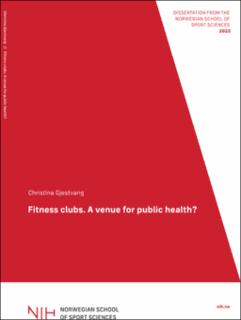| dc.contributor.author | Gjestvang, Christina | |
| dc.date.accessioned | 2022-02-18T10:36:48Z | |
| dc.date.available | 2022-02-18T10:36:48Z | |
| dc.date.issued | 2022 | |
| dc.identifier.isbn | 978-82-502-0599-4 | |
| dc.identifier.uri | https://hdl.handle.net/11250/2979992 | |
| dc.description | Avhandling (doktorgrad) - Norges idrettshøgskole, 2022 | en_US |
| dc.description.abstract | Background: The health benefits of regular physical activity (PA) are well known. Still, about 70% of European adults are insufficiently physically active. Thus, a further understanding of how modifiable factors such as socioeconomic status and psychosocial variables (e.g. body image, selfefficacy, social support, perceived motives and barriers) differ between those who choose to participate in PA and those who do not is warranted. This is essential for successful PA promotion and to enhance public health. Also, it is not only important to understand the differences between active and inactive individuals, but also the settings where PA occurs, which may make PA participation more or less likely. A fitness club represents one PA setting. Yet, <40% of members exercise at the fitness club regularly and the dropout rates are high. Despite this, research on exercise participation, especially of new members (at a high risk of dropout) is limited in quantity and quality. Thus, it is important to gain in-depth knowledge of those adults who choose to be fitness club members and are able to exercise regularly.
Aims: The principal aim of the present PhD-project was to gain an increased understanding of those individuals who choose to join a fitness club, and are able to stay active, and continue with, regular exercise in a group of novice exercisers in their first year of a fitness club membership. Methods: This thesis is based on the research project “Fitness clubs. A venue for public health?”, a 12 months prospective study with four follow-ups conducted from October 2015 to November 2018. Participants were 250 fitness club members (<4 weeks of membership) classified as novice exercisers (structured exercise <60 min./week the last six months). All participants responded to an electronic questionnaire, including body image, motives and barriers, self-efficacy, social support, life satisfaction, exercise attendance, use of the fitness club, and customer satisfaction. Half of the participants (n = 125) underwent repeated measures of total PA level (two follow-ups), body composition, maximal oxygen uptake, and maximal muscle strength (three follow-ups).
Main results: I) Total PA level or numbers meeting PA recommendations did not change from start-up to 12 months (38% versus 46%). Socioeconomic status was not associated with regular use of the fitness club. II) Body area evaluation and appearance satisfaction improved in all members, and regular exercise was associated with a more positive body image, appearance and body area satisfaction across the follow-up. At start-up, being male and having a BMI<25 was associated with reporting a more positive body image. III) Repeated physical testing was not associated with regular exercise attendance. Across the year, only 17% reported regular exercise attendance at the fitness club. The most common workout mode was individual resistance Introduction exercise (50%). Few attended group exercise classes (23%) or used a personal trainer (4%). IV) Less than half (37%) exercised regularly (at both the fitness club and in other settings) across the follow-up. Most members were motivated by factors such as “positive health”, “increase in physical fitness” and “mobility”, and the most common barrier was “priority” (such as lack of time). Regular exercisers rated the motives “enjoyment” and “challenge” as more important than non-regular exercisers. V) Those exercising regularly at each follow-up had higher scores of “enjoyment” and self-efficacy (“sticking to it”). Social support from family and friends was also greater in those reporting regular exercise.
Conclusions: A fitness club membership was not associated with increase in total PA level or numbers meeting PA recommendations. Regular exercise attendance was associated with higher scores in body image total score, appearance and body area satisfaction, “enjoyment” and “challenge”, self-efficacy “sticking to it”, and social support from family/friends. Most new members use the fitness club intermittently and do not achieve regular exercise behavior. With only 17% exercising two days or more weekly across the first year of membership, there is a need to develop strategies to improve exercise attendance among novice exercisers. | en_US |
| dc.language.iso | eng | en_US |
| dc.relation.haspart | Paper I: Gjestvang, C., Stensrud, T., Hansen, BH., Kolle, E., Haakstad, LAH. (2019) Are fitness club members likely to meet the current PA recommendations? Translational Sports Medicine, 3(2), 75-83. | |
| dc.relation.haspart | Paper II: Haakstad, LAH, Jakobsen, C., Solberg, RB., Sundgot-Borgen, C., Gjestvang, C. (2021) Mirror, mirror - does the fitness club industry have a body image problem? Psychology of Sport & Exercise, 53, 1-7. | |
| dc.relation.haspart | Paper III: Gjestvang, C., Stensrud, T., Paulsen, G., Haakstad, LAH. (2021) Stay True to Your Workout: Does Repeated Physical Testing Boost Exercise Attendance? A One-Year Follow-Up Study. Journal of Sports Science and Medicine, 20, 35-44. | |
| dc.relation.haspart | Paper IV: Gjestvang, C., Abrahamsen, F., Stensrud, T., Haakstad, LAH. (2020) Motives and barriers to initiation and sustained exercise adherence in a fitness club setting - a one-year follow-up study. Scandinavian Journal of Medicine & Science in Sports, 30(9), 1796-1805. | |
| dc.relation.haspart | Paper V: Gjestvang, C., Abrahamsen, F., Stensrud, T., Haakstad, LAH. (2021) What makes individuals stick to their exercise regime? A one-year follow-up study among novice exercisers in a fitness club setting. Under revision in Frontiers of Psychology (April 2021). | |
| dc.subject | nih | en_US |
| dc.subject | doktoravhandlinger | en_US |
| dc.title | Fitness clubs: A venue for public health? | en_US |
| dc.type | Doctoral thesis | en_US |
| dc.description.version | publishedVersion | en_US |
| dc.description.localcode | Institutt for idrettsmedisinske fag / Department of Sports Medicine | en_US |
